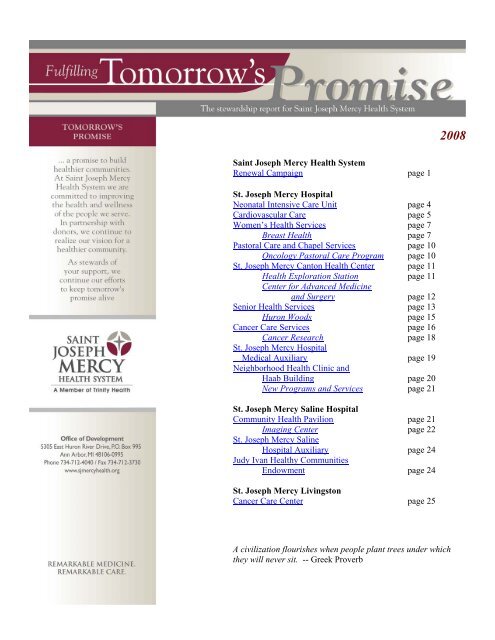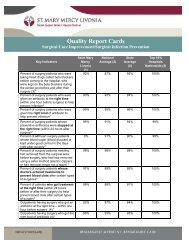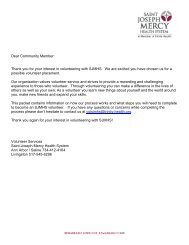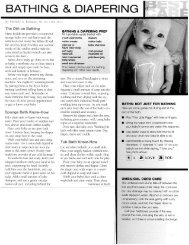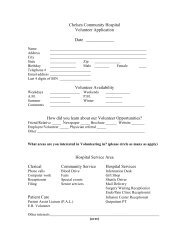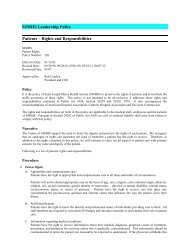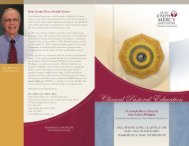Saint Joseph Mercy Health System
Saint Joseph Mercy Health System
Saint Joseph Mercy Health System
Create successful ePaper yourself
Turn your PDF publications into a flip-book with our unique Google optimized e-Paper software.
2008<strong>Saint</strong> <strong>Joseph</strong> <strong>Mercy</strong> <strong>Health</strong> <strong>System</strong>Renewal Campaign page 1St. <strong>Joseph</strong> <strong>Mercy</strong> HospitalNeonatal Intensive Care Unit page 4Cardiovascular Care page 5Women’s <strong>Health</strong> Services page 7Breast <strong>Health</strong> page 7Pastoral Care and Chapel Services page 10Oncology Pastoral Care Program page 10St. <strong>Joseph</strong> <strong>Mercy</strong> Canton <strong>Health</strong> Center page 11<strong>Health</strong> Exploration Station page 11Center for Advanced Medicineand Surgery page 12Senior <strong>Health</strong> Services page 13Huron Woods page 15Cancer Care Services page 16Cancer Research page 18St. <strong>Joseph</strong> <strong>Mercy</strong> HospitalMedical Auxiliary page 19Neighborhood <strong>Health</strong> Clinic andHaab Building page 20New Programs and Services page 21St. <strong>Joseph</strong> <strong>Mercy</strong> Saline HospitalCommunity <strong>Health</strong> Pavilion page 21Imaging Center page 22St. <strong>Joseph</strong> <strong>Mercy</strong> SalineHospital Auxiliary page 24Judy Ivan <strong>Health</strong>y CommunitiesEndowment page 24St. <strong>Joseph</strong> <strong>Mercy</strong> LivingstonCancer Care Center page 25A civilization flourishes when people plant trees under whichthey will never sit. -- Greek Proverb
Page 2 of 27Each patient room will include a full bathroom with a barrier-free shower. The new rooms will be decorated inwarm, inviting colors and fabrics, and have rich, cherry wood trim and cabinetry. Amenities include wirelessInternet access and have a flat-screen television with on-demand access to SJMH's patient education videolibrary and guest services. The new TVs will be equipped with additional patient specific information andcomputerized games (proven to serve as a healthy distraction). And, there will be separate lighting and soundcontrols in the patient and family zones to ensure that the patient is always comfortable.Each room is equipped with double doors to widen the entrance when needed and mechanical lifts fortransferring a patient to and from the bed to improve safety for patients and staff.After completion of the seven-story North Tower, work on the main entrance and new chapel will begin. Thenew chapel will be much larger, accommodating approximately 140 individuals for services and celebrations(the current chapel seats 85). The chapel will include a large foyer and main gathering room plus a separateinterfaith meditation room and an adjacent healing garden. The garden will lead directly to the labyrinth(outside of the Cancer Care Center) making this unique spiritual element easier to access. In addition, the newchapel will incorporate cherished and valuable design elements from the current chapel such as the stained glassand the liturgical artwork that honor a legacy of support and partnerships.Philanthropic support has and will continue to play a vital role in building the Patient Towers. The entireproject is expected to be completed in 2011, coinciding with the <strong>Health</strong> <strong>System</strong>’s centennial celebration –marking 100 years of serving the community.Surgery PavilionIn FY08, a generous lead gift from the family of Dudley and Dawn Holmes was given to name The Helen andMarion S. DeWeese, MD, Surgery Pavilion at SJMH. (The DeWeeses are Dawn’s parents.) The new name ofthe Surgery Pavilion was formally celebrated by Dr. DeWeese’s family, friends and former colleagues atSt. <strong>Joseph</strong> <strong>Mercy</strong> Hospital on June 10, the 34 th anniversary of Dr. DeWeese joining the St. Joe’s medical staff.Support for the Surgery Pavilion project allowed SJMH to build a state-of-the-art facility with eighteen 21 stcentury operating suites. Design features of the operating suites included:Larger operating suites – each one went from an average size of 375 square feet to 625 square feet toaccommodate advanced surgical equipment and the number of staff needed to perform surgeriesCeiling-mounted boom arms that hold lights, monitors and equipment for easy movement, increasedfloor space and increased safetyMonitors with capabilities to display real-time images from the operating rooms to other linkedlocations so that off-site specialists can share opinions, or procedures can be observed for educationalpurposesComputerized patient record systemThe new Surgery Pavilion has more than double the number of patient preparation and recovery rooms for atotal of 40. And, each room has more than doubled from 50 to 110 square feet so that family members cancomfortably stay with the patient before and after procedures.
Page 3 of 27The welcoming new family waiting area is triple the size of the previous family space, increased from 1,300square feet to 4,400 square feet. The new space has an open main registration desk located near the entrance.Patients are immediately greeted by a friendly face upon check in for surgery, and family members have readyaccess to updates on the patient’s condition. The room is arranged into seating alcoves for improved comfortand privacy. It includes comfortable furniture, appealing artwork, a soothing water feature and flat-screentelevision sets. Other amenities include wireless Internet access, cell phone nooks for private calls and lockersto store visitors’ personal belongings.In addition, within the family area, three consultation rooms provide families with a convenient and privatelocation to meet with members of the surgical team before, during and after procedures.da Vinci Surgical <strong>System</strong> and Robotic Surgery ProgramCommunity support made it possible to purchase the da Vinci Surgical <strong>System</strong> in 2006, and to vastly expandits utilization at St. Joe’s Ann Arbor. The da Vinci robot is now being used for robot-assisted prostatectomiesand gynecologic surgeries as well as minimally invasive cardiovascular, thoracic, pulmonary andgastrointestinal procedures such as:Internal mammary artery harvestingMinimally invasive Direct Coronary Artery Bypass (MID-CAB)Treatment of mitral valve disease and cardiac tumorsVideo-Assisted Thorascopic Surgery for lung cancerRepair of paraesophageal hernia and other benign esophageal diseaseNissen fundoplication for gastroesophageal reflux diseaseThymectomy – the removal of the thymus gland, which is located behind the breastbone or sternumPatient volumes for robotic surgery at St. Joe’s have also grown significantly. In the first year, surgeons treated95 patients using the da Vinci. With ongoing training and development, in 2007, the number of proceduresusing the robot more than doubled, reaching 198. And, at the end of 2008, more than 300 St. Joe’s patientsbenefited from surgeries performed using theda Vinci.Plans to increase the uses of the da Vinci at SJMH continue. The potential for this advanced equipment is vast.With the addition of this state-of-the-art robot, surgeons at SJMH will continue to lead the way in thedevelopment and performance of safer, more effective surgical procedures. The advantages of using the daVinci in such procedures include reduced blood loss, less risk of infection, minimized pain, quicker return tonormal function, less scarring, fewer side effects and higher patient satisfaction.More information about the da Vinci Surgical <strong>System</strong> and the Robotic Surgery Program – pages 5 and 8St. <strong>Joseph</strong> <strong>Mercy</strong> LivingstonAs part of the Renewal Campaign, St. <strong>Joseph</strong> <strong>Mercy</strong> Livingston partnered with the community to build the newWarren R. and Lauraine A. Hoensheid Cancer Center. During FY08, the majority of community gifts weredesignated in support of programs and research and for care of the underserved at the new facility.More information about St. <strong>Joseph</strong> <strong>Mercy</strong> Livingston and the cancer center – page 25
Page 4 of 27St. <strong>Joseph</strong> <strong>Mercy</strong> Saline HospitalAt St. <strong>Joseph</strong> <strong>Mercy</strong> Saline Hospital, community support for the Renewal Campaign during FY08 benefited theCommunity <strong>Health</strong> Pavilion project. The Pavilion will comprise an addition to the existing hospital andextensive interior renovations (begun in 2002) including a new clinical laboratory and a state-of-the-art ImagingCenter. Nearly completed, the Imaging Center will be followed by a new main entrance, pharmacy, visitorareas and gift shop as well as a new community room.More information about St. <strong>Joseph</strong> <strong>Mercy</strong> Saline – page 21St. <strong>Joseph</strong> <strong>Mercy</strong> HospitalNeonatal Intensive Care UnitThe NICU at SJMH offers diagnostic services and treatment for more than 900 sick and critically ill newbornseach year. Neonatologists supervise care in the NICU and work with a team of neonatal nurse practitioners,nurses, respiratory therapists, social workers, case managers and lactation consultants. The NICU staffembraces a family-centered care approach – the family is viewed as an integral part of the healing process andinvolvement is highly encouraged.St. <strong>Joseph</strong> <strong>Mercy</strong> Hospital developed the Family Advisory Board (FAB) to help ensure that families’ needswere being met while they were receiving care at the NICU. The Board’s goals are to aid and enhance theadvanced medical services and compassionate care provided to infants in the NICU and to offer parents muchneeded support and education.In November, FAB held its fourth annual Fashionable Growth fashion show as a tribute to Board members’life-changing NICU experiences and to provide an opportunity for individuals and organizations to support theNICU. More than 300 tickets were sold. Proceeds from ticket sales and the silent auction help FAB to offereducational and support programs to families at St. Joe’s NICU.Every three weeks, members of FAB work with a NICU nurse to offer a 2 ½ hour session about dischargeplanning, developmental care and health issues such as apnea. In addition, the class engages parents in creativeprojects such as making nametags and birth announcements and starting journals. Once a month, FAB sponsorspizza night in the private waiting space on the Unit and families are invited to enjoy dinner and the support ofothers who are in similar situations. And, the group sponsors the annual Preemie Reunion – in 2008, more than500 families attended the special event.During FY08, gifts from generous community members aided in the purchase of approximately 500 Infant CPRAnytime® kits. This program allows St. Joe’s to equip families, free of charge, with kits that teach them how toperform infant CPR. This can be critical for babies going home on oxygen, who are suffering from apnea orwho are otherwise compromised due to breathing issues.In 2008, St. Joe’s NICU launched a training program for staff using the SimNewB neonatal simulator. Thisrealistic simulator helps to provide hands-on, interactive staff training in resuscitation and other clinicalprocedures. The simulator is extremely life-like – it cries, hiccups, has a heartbeat, moves its arms and legs andturns blue if it is not getting enough oxygen. St. Joe’s was one of the first hospitals in the nation to use theSimNewB to help enhance clinical staff expertise.
Page 5 of 27In addition, St. Joe’s offered a conference for staff in January 2008 to establish its Infant Driven FeedingProgram. The goal is to make the transition from tube feeding to oral feeding as positive and effective aspossible. Data is being studied to determine whether or not babies who are fed orally sooner and morefrequently advance quicker and as a result are able to go home sooner.Cardiovascular CareSt. <strong>Joseph</strong> <strong>Mercy</strong> Hospital’s Michigan Heart & Vascular Institute (MHVI) has 50 board certified cardiologists,cardiac surgeons, vascular surgeons and interventional radiologists who work with a specialized team of skillednurses, technologists, physician assistants, social workers, nutritionists and exercise physiologists.SJMH’s superior level of expert care has been recognized with the Society of Thoracic Surgeons’ 3-Star Rating(the group’s highest award). St. Joe’s in Ann Arbor has been ranked as one of the nation’s 100 Top Hospitalsfor Cardiovascular Care for four years by Thomson Reuters. In addition, Blue Cross Blue Shield of Michiganhas named the Hospital as a Cardiac Center of Excellence.Patients turn to St. Joe’s for advanced diagnosis, the latest treatments, traditional and minimally invasivesurgery options, active research, renowned rehabilitation, vital education and support services, andcomprehensive inpatient care. St. Joe’s MHVI is one of the largest cardiovascular disease centers in Michiganand has one of the highest volumes in the state.Annual volumes:Cardiac Catheterizations- 2,600 Coronary Diagnostic Procedures- 1,350 Percutaneous Coronary InterventionsElectophysiology and Arrhythmia- 2,100 Therapeutic ProceduresCardiothoracic Surgery- 650 Coronary Bypass and Valve Surgeries- 480 Thoracic SurgeriesVascular Medicine and Surgery- 18,000 Non-invasive Diagnostic Procedures- 900 Vascular Surgeriesda Vinci® Robotic Surgical <strong>System</strong>Past gifts helped to develop St. Joe’s Robotic Surgery Program and purchase of the da Vinci Robotic Surgical<strong>System</strong>. St. Joe’s leads the way in developing new treatments using the da Vinci, including internal mammaryartery harvesting, direct coronary artery bypass and epicardial pacemaker lead placement. In addition, it is nowused to treat mitral valve disease, cardiac tumors and atrial septal defects.More information about the da Vinci Surgical <strong>System</strong> and the Robotic Surgery Program – pages 3 and 8CardiacAdvantageDuring FY08, St. Joe’s escalated its dedication to patient-centered care and staff collaboration by launching theCardiacAdvantage program. St. Joe’s is proud of this treatment philosophy, which promotes a focus oncommunication. Primary and specialty care are coordinated every step of the way to ensure immediate,
Page 6 of 27comprehensive services and results from diagnosis to treatment to rehabilitation to recovery. This is a uniquecollaborative, multi-disciplinary method – very few health care systems regularly use this type of team approachto treat their patients.In addition, throughout the year, an interdisciplinary team made up of physicians, nurses, social workers, andother staff met weekly to review operations and address all issues that impact patient satisfaction. Based onpatient satisfaction survey scores, the group created action plans to improve quality of care in areas such as painmanagement and discharge planning/patient education.New Clinical AdvancementsCartoid Artery StentingMHVI has begun offering a new treatment for patients who have a build up of plaque in one or more of theircarotid arteries and who have a history of heart disease or have had a stroke or mini stroke. This new minimallyinvasive procedure is an alternative to open surgery. A catheter is inserted through a small incision made in theleg and it is guided through the body to the neck to treat and remove the blockage. In addition to performingthis procedure, St. Joe’s is participating in national research studies to gain more knowledge regarding protocolsand outcomes.A Cure for Atrial Fibrillation – Thorascopically Guided Epicardial Atrial Fibrillation AblationAtrial Fibrillation is estimated to affect more than 2 million adults in the United States. It is the most commonarrhythmia in the elderly persons, and is a major risk factor for stroke. Experts have recently made strides inefforts to better understand atrial fibrillation, which has has led to the development of advanced techniques forthe treatment. One new treatment is radiofrequency catheter endovascular ablation. This leading-edgeprocedure was recently introduced at St. <strong>Joseph</strong> <strong>Mercy</strong> Hospital as a collaborative effort between thecardiothoracic surgery and electrophysciology departments. Initial results are very encouraging with respect toboth patient outcomes and satisfaction. A recent report given at the 2009 American College of CardiologyConference suggests the rate of curing patients using this procedure may be as high as 90% at one-year followup.Other patient benefits include smaller incisions, faster recovery and shorter length of stays as compared totraditional treatment.Screening, Education and Support ProgramsDuring FY08, philanthropic support made it possible for MHVI to continue offering a wide variety ofcommunity education programs for children and adults free of charge. One example of this was the <strong>Health</strong>yHearts 101 educational outreach program developed for school-aged children. The program is run strictly withfunds donated by community members. Since it began in 2005, it has served more than 9,000 students. Twiceeach month, Manak Sood, MD, spends a half day leading this innovative program that engages children andteaches them of the risks factors for cardiovascular disease, especially smoking. During FY08, in addition tothe two monthly programs, MHVI staff also visited Saline Schools to present to more than 400 students.Other popular classes include …And the Beat Goes On and Yoga for <strong>Health</strong>. In addition, a Heart FailureEducational Series was offered at the Towsley Senior <strong>Health</strong> Building on St. Joe’s campus in Ann Arbor duringthe months of October and November in 2008. The series was provided in three parts and the topics included:What is Heart Failure?, Heart Failure Medications, Why sign up for Medicare Part D?, Eating to Manage YourHeart Failure, Why Do I Need Exercise? and Coping with Chronic Illness.
Page 7 of 27In September of 2008, St. Joe’s held a free day of screening for Peripheral Artery Disease (PAD) at MHVI –more than 110 individuals benefited from this pain-free test. PAD is a vascular disease that most often resultsin the narrowing of vessels that carry blood to the legs, arms, stomach or kidneys. Because it often goesundiagnosed, offering a screening day aids in early detection and creates a first step for those who needtreatment.The New Heart HospitalAs part of the Renewal Campaign, St. Joe’s is building the new Heart Hospital, which will be located in thePatient Towers on the Ann Arbor campus – it will be an important part of the comprehensive, state-of-the-artcardiovascular care the Hospital provides. The cardiac medicine, cardiac surgery and vascular surgery unitswill serve pre and post-operative cardiovascular surgery patients and those who require 24-hour monitoring andintensive care. St. Joe’s provides inpatient care to approximately 8,000 cardiovascular patients each year.The concentration of these units together in the Heart Hospital will promote better coordination and efficiencyamong staff for improved outcomes. It will be a center of excellence for inpatient care – supporting advancedcardiovascular medicine in a healing environment.Women’s <strong>Health</strong> ServicesThe Ellen Thompson Women’s <strong>Health</strong> Center was designed to offer a soothing, healing environment for womento receive high-quality, specialized health services. Programs at the Women’s <strong>Health</strong> Center focus on the wholeperson – body, mind and spirit – and address the changing health care needs of women throughout theirlifetime.Breast <strong>Health</strong>According to the American Cancer Society, more than 180,000 new cases of breast cancer were diagnosedamong women in the United States in 2008; and more than 40,500 women died of the disease that same year.The Women’s <strong>Health</strong> Center is dedicated to the prevention of breast cancer. Philanthropy supports breast careeducation, counseling, and diagnostic and screening services including mammograms and ultrasounds providedthere.<strong>Saint</strong> <strong>Joseph</strong> <strong>Mercy</strong> <strong>Health</strong> <strong>System</strong> conducted nearly 49,000 mammograms in 2008. Gifts from the communityalso helped to make it possible for SJMHS to provide a day of low-cost mammograms, which benefited 125women who were unable to afford this service.Digital MammographyIn recent years, digital mammography has emerged as the state-of-the-art technology for breast cancer diagnosisand screening. A study released in late 2005 showed that digital mammography offers significantly betterimaging for women who are under the age of 50 years and for women of all ages who have dense breast tissue.(The imaging for women who do not fit either of these categories is comparable on digital and standardmammography equipment.)Last spring, SJMHS received a gift of $1.5 million from Robert and Ellen Thompson (for whom the Women’s<strong>Health</strong> Center is named) to aid in the conversion to a digital mammography system. This gift along with thosefrom other individuals and community organizations helped to complete the conversion last fall. The <strong>Health</strong><strong>System</strong> now has 13 digital mammography units, with 8 of those units housed within the Women’s <strong>Health</strong>
Page 8 of 27Center and the remaining units at its hospitals in Howell and Saline and at three of its outpatient centers – thePlymouth <strong>Health</strong> Building; Canton <strong>Health</strong> Center and Woodland <strong>Health</strong> Center.The new digital system provides the benefits of increased accuracy, convenience and efficiency. It alsoincreases safety for patients and care providers by using 30%-50% less radiation than traditionalmammography. Above all, digital mammography helps St. Joe’s to identify breast cancers earlier in somecases, which improves the odds of successful treatment.Converting to an entirely digital format allows the <strong>Health</strong> <strong>System</strong> to continue providing technologicallyadvanced, compassionate, professional care to patients.In addition to superior diagnostic and support services, gifts for breast health have been designated for leadingedgeresearch and advanced treatment. The Women’s <strong>Health</strong> Center helps to connect women to breast cancerservices throughout the <strong>Health</strong> <strong>System</strong>, including chemotherapy, radiation therapy, surgery and inpatient care.More information about Cancer Care Services – page 16da Vinci RobotIn FY08, St. Joe’s made a presentation to the community regarding the minimally invasive gynecologicprocedures and surgery options that the Hospital offers using state-of-the-art equipment such as the da Vincirobot. When medication and non-invasive procedures are unable to relieve symptoms or address disease,surgery remains the most effective treatment for a range of gynecologic conditions including cervical anduterine cancer, uterine fibroids, endometreosis, uterine prolapse and menorrhgia.The latest minimally invasive gynecologic procedures enable surgeons to access target anatomy, which may notrequire an external incision. For complex hysterectomies and other gynecologic procedures, robot-assistedsurgeries using the da Vinci robot may be the most effective, least invasive treatment option. Through tiny oneto two centimeter incisions, surgeons using theda Vinci can operate with greater precision and control. The minimally invasive options help to minimize thepain and risk such as bleeding, damage to surrounding organs and nerves and extended recoveries that areassociated with traditional open gynecologic surgery. These advanced minimally invasive approaches haveproven excellent clinical outcomes.More information about the da Vinci Surgical <strong>System</strong> – pages 3 and 5Heart of a WomanHeart disease manifests itself in significantly different ways in women than it does in men. Most notably, thereis a wider variation in symptoms, which can result in a lack of attention to serious heart conditions or episodes.Coronary artery disease remains the number one cause of death for American women over the age of 40 andmore than 1,200 die from heart disease each day.The Women’s <strong>Health</strong> Center implemented the Heart of a Woman program to encourage women to becomeinformed and to seek diagnostic and treatment services. The program includes an exam, cholesterol profile andeducational materials. And, because heart disease and those at risk for heart disease often have compounding
Page 9 of 27illnesses such as diabetes and hypertension, treatment and prevention of these conditions is addressed. Inaddition, the program connects women to resources that can help to manage these diseases includingindividualized nutrition consultations, stress management classes, exercise evaluations and classes, weight lossmanagement services and mental health coaching.Fitness, Nutrition and WellnessPhilanthropic support was the foundation for the Women’s <strong>Health</strong> Center’s health education, fitness andnutrition programs. During FY08, the Center continued to offer classes designed to promote general health andwellness or to combat specific diseases and conditions.Last year, nearly 850 students participated in the Women’s <strong>Health</strong> Center fitness classes including strengthtraining, yoga, cardio and pilates. In addition, more than 1,230 individuals benefited from personal fitnessassessments and personal training sessions.More than 40 participants benefited from the class Increasing Strength and Bone Density, which wasspecifically developed to aid women diagnosed with osteoporosis or osteopenia. Individuals receivedinstruction and a fitness band and were able to practice exercises that they could repeat at home or the gym tohelp increase bone density. The specialized class received positive responses from those who attended.The Women’s <strong>Health</strong> Center also offered a variety of nutrition programs and hands-on cooking classes duringFY08. More than 37 different cooking classes were offered with titles like Hooked on Fish and D.A.S.H.:Dietary Approaches to Stop Hypertension. In total, 222 participants attended the classes. In addition, morethan 170 students participated in the HMR Program for Weight Management®, which promotes rapid andsignificant weight loss through in-depth lifestyle education, personalized attention and intensive follow-upservices.SJMHS’s 2008 wellness classes addressed stress, life-changes and life skills to help avoid illness and injury,manage one’s health and improve quality of life. 646 participants benefited from classes such as Boot Camp forNew Dads, Heart to Heart: Conversations for Mothers and Daughters on Puberty and Growing Up, and CPRFamily and Friends.In addition, philanthropic support helps the Women’s <strong>Health</strong> Center to continue to provide bone density testing,a midlife services program, massage therapy, a continence clinic and access to colon cancer screening forwomen.St. <strong>Joseph</strong> <strong>Mercy</strong> Center for DiabetesSince 2003, the St. <strong>Joseph</strong> <strong>Mercy</strong> Center for Diabetes has been located in the Women’s <strong>Health</strong> Center andoverseen by the director of Women’s and Children’s Services. Center for Diabetes staff provide comprehensivediabetes education and medical services, which focus on the improvement of diabetes self-management skillsby involving family or support persons.In FY08, the Center for Diabetes provided services to 1,381 individuals who made a combined total of 4,500visits. Specialized services were offered to treat patients needing specialized education, insulin pump therapyand continuous glucose monitoring. In addition, patients were seen to monitor complications related topregnancy and gestational diabetes.
Page 10 of 27Patient Volumes:Continuous glucose monitoring – 39Insulin start – 87Consultations and initiation for insulin pump therapy – 36Assistance with insulin algorithms – 83Review courses – 32In order to improve patient satisfaction, appointment scheduling was reorganized under the <strong>Health</strong> <strong>System</strong>’scentral network. This increased the times of day in which patients and families were able to directly reach ascheduler and decreased wait times when calling.Pastoral Care and Chapel ServicesThe <strong>Saint</strong> <strong>Joseph</strong> <strong>Mercy</strong> <strong>Health</strong> <strong>System</strong> pastoral ministry staff made up of 22 chaplains and administratorsprovide spiritual support to our patients and their families. During FY08, this team developed and maintainedprograms and services that focus on compassion, hope, comfort and spiritual and emotional strength.Chapel ServicesHundreds of patients, visitors and staff rely on the chapel to be a quiet place where they can go for reflection,solace and prayer. In 2008, gifts for the chapel helped to provide daily Catholic mass, Saturday and Sundayvigil mass and occasional memorial services. And, we continued to broadcast the mass on a closed-circuitHospital television station and provide the Eucharist to patients who wished to participate in the sacrament butwere unable to leave their rooms.Oncology Pastoral Care ProgramGenerous gifts made in FY08 helped to maintain the Oncology Pastoral Care program atSt. <strong>Joseph</strong> <strong>Mercy</strong> Hospital’s Robert H. and Judy Dow Alexander Cancer Center and the Warren R. and LauraineA. Hoensheid Cancer Center at St. <strong>Joseph</strong> <strong>Mercy</strong> Woodland <strong>Health</strong> Center. A full-time outpatient oncologychaplain, who possesses expertise in ministry to cancer patients and their loved ones, divides his time betweenthe two locations. The Oncology Pastoral Care program recognizes that people are often spiritual by natureregardless of religious beliefs, and that spiritual care promotes healing.The oncology chaplain supports patients and families who are receiving outpatient, inpatient, palliative, hospiceand follow-up services. The oncology chaplain helps to make the clinical setting more welcoming. He helpspatients to cope with the physical and emotional stress of cancer by listening to and conversing with them,offering counseling, praying with them, and organizing group activities. Through support, hope and comfort,this program helps to meet the emotional and spiritual needs of patients and families who are facing cancer.During FY08, the oncology chaplain held a seminar for caregivers that benefited oncologists, radiologists,nurses and other clinical staff who provide care and treatment to those diagnosed with cancer. The seminarhelped staff hone their skills at providing compassionate care to patients and families, to network and share bestpractices and to rejuvenate their passion for the work they do.In addition, the <strong>Health</strong> <strong>System</strong> established a patient advocacy group. As a first step, the oncology chaplain anda cancer survivor who received treatment and participated in research studies at St. Joe’s both attended aseminar at Mayo Clinic to learn about the model used there. The group will connect patients who are
Page 11 of 27considering participation in research trials with others who have first-hand experience. They will also offer thepatient perspective to research clinicians so that they may continue to provide the best possible care.EducationDuring FY08, SJMHS continued to work with interns as part of the Clinical Pastoral Education (CPE) program,a form of theological education that takes place primarily in clinical settings where ministry is being practiced.CPE credits are often a requirement for ordination within certain churches and can also serve as an avenue inbecoming a pastoral care minister. The student interns act as ministers and learn through the experiences andfacilitated group reporting. SJMHS supported a total of 12 interns in FY08.In 2008, SJMHS held two CPE Professional Advisory Group meetings. The group consists of pastoral careleaders, physicians, managers and nurse leaders who conduct the interns’ exit interviews and are responsible foraddressing any concerns. SJMHS has implemented this process as a requirement to becoming a CPE Center bythe Association for Clinical Pastoral Education, Inc. (ACPE) and expects to reach this goal within two to threeyears.Bereavement Guide ProgramThroughout the <strong>Health</strong> <strong>System</strong>, as part of this program, chaplains, nurses and nurse supervisors who are trainedin the bereavement care provide compassionate support to families of patients who have died.In FY08, philanthropic support helped to provide families with a packet of materials that included a booklet ongrieving, a list of bereavement support groups, suggested scripture readings from a number of world religions,and answers to frequently asked questions. Families also received a specially created pamphlet, You Are NotAlone. Gifts helped to purchase and produce materials; annually, approximately 2,000 packets are provided tofamilies during a very difficult time in their lives.St. <strong>Joseph</strong> <strong>Mercy</strong> Canton <strong>Health</strong> CenterThe St. <strong>Joseph</strong> <strong>Mercy</strong> Canton <strong>Health</strong> Center was opened in 1998 and offers primary and urgent care, diagnosticimaging and clinical laboratory testing, interactive youth education programs and physical medicine andrehabilitation services. The Center also houses a number of specialty medical practices including cardiology,urology, allergy, ear nose and throat, neurology, and orthopedic and plastic surgery. The Canton <strong>Health</strong> Centernot only provides patients and families with superior outpatient services, it also allows for seamless access tospecialty and inpatient services at St. <strong>Joseph</strong> <strong>Mercy</strong> Hospital in Ann Arbor.St. <strong>Joseph</strong> <strong>Mercy</strong> <strong>Health</strong> Exploration StationThe Canton <strong>Health</strong> Center also houses the St. <strong>Joseph</strong> <strong>Mercy</strong> <strong>Health</strong> Exploration Station (completed in 1999),which is the first interactive health education center built in Michigan. Throughout FY08, (2007-2008 schoolyear) more than 305 groups, representing 25 different school districts, dozens of private schools, home schools,pre-schools and scout troops, visited the <strong>Health</strong> Exploration Station (HES). A visit most often includes a 40 to50 minute classroom presentation, and exploration time in the exhibit gallery. Groups ranged in age from 3-year-old pre-school students to college students studying education. In total, during FY08, over 14,000 studentsand adults benefited from the interactive educational programs – more than 1,200 were able to experience HESfree of charge on open house days provided the fourth Thursday of each month. Since opening, 140,000individuals have participated in programs at HES.
Page 12 of 27Programs offered at HES are designed to support and enhance classroom instruction and meet several statecurriculum objectives including those set by the Michigan Department of Education in its <strong>Health</strong> EducationContent Standards and Benchmarks and Michigan Curriculum Framework of Science Content Standards andBenchmarks. The most popular programs were:Pre-kindergarten through 2 nd Grade: Inside You - A program that helps to create awareness aboutthe body with a special emphasis on the five senses3 rd through 5 th Grade: How Your Body Works – This program provides an overview of the 10 majorbody systems and ways to keep them safe and maintain one’s healthA philanthropic gift from the SJMH Medical Auxiliary made it possible to offer a program to parents titled,Drugs 101: What Parents Need to Know. Other special programming included a class that guides parents ineducating their children about sex. A condensed version was piloted with a local PTO and was well received.In addition, HES continued to provide camps during the summer months; Amazing Me had 17 participants, andGirls Empowered had 10 participants in each of the two sessions offered.During FY08, outreach and community partnerships remained an important part of the <strong>Health</strong> ExplorationStation focus. Staff participated in the local Mending the Safety Net and Passport to Safety expos at theDickenson Center in Livonia. There they introduced the <strong>Health</strong> Exploration Station and <strong>Health</strong> <strong>System</strong> todozens of school counselors, social workers, administrators and teachers. In addition, groups including YouthLeadership Canton and Plymouth, the Everest Institute Nursing Tech Program, Ross Medical EducationalCenter, and <strong>Mercy</strong> Leadership Academy were welcomed to tour HES and learn about the programs offeredthere and the positive impact on children and adults who participate.Last year, the HES classrooms and exhibits underwent some upgrades and repairs. The original projectors werereplaced with new LCD models in each classroom. And, new carpet was laid in the “digestive tunnel.”Maintaining the appearance of the classrooms and exhibits helps to ensure the quality education servicesprovided at HES.Center for Advanced Medicine and SurgeryIn 2006, SJMHS began to develop plans to renovate and expand the Canton <strong>Health</strong> Center to create the St.<strong>Joseph</strong> <strong>Mercy</strong> Canton Center for Advanced Medicine and Surgery. Ground was broken in 2008, andconstruction is on schedule for completion in fall 2009. This project, which has been supported byphilanthropic gifts, will take place in phases and add capabilities at this popular location.Phase IImaging Services ExpansionIn FY08, the Imaging Center was completely renovated including the expansion and update of exam rooms thatpromote patient comfort and privacy. In addition, new technologically advanced imaging equipment waspurchased including digital mammography, a 64-slice CT scanner and a mobile and stationary MRI.
Page 13 of 27Entrance and Lounge RenovationRefurbishing the public areas of this ten-year-old facility will also be part of Phase I. The original canopy andmain entrance will be replaced with an updated architectural design. In addition, the lounge area will beremodeled and will include new furniture and fresh paint and finishes.Phase II and Phase IIIThis construction project includes the addition of an Ambulatory Surgery Center and office space for specialtyphysician practices. Once completed, outpatient surgical procedures in specialty areas such as orthopedics;cardiology and thoracic surgery; and otolaryngology will be provided there. And, the new office space willattract more physician practices to the area to address specialty care needs of the community.Another highlight of the project is the construction of a new Cancer Center at this site to help meet the needs ofoncology patients residing in the area. The Cancer Center will include a full range of cancer care servicesincluding chemotherapy, radiation therapy and support programs.RapidArcThe new Cancer Center will be the first in Southeast Michigan to offer radiation therapy using RapidArctechnology. This state-of-the-art system is the latest approach to image-guided, intensity-modulated radiationtreatment (IGRT/IMRT) – enabling beams with varying intensity of radiation to be aimed at the tumor frommultiple angles. RapidArc makes it possible to program the linear accelerator to deliver more precise treatmentin a shorter time than traditional radiation treatments. In most cases one treatment lasts less than two minuteswith the linear accelerator making a full rotation around the patient.RapidArc will be a valuable addition to the treatment options already available at <strong>Saint</strong> <strong>Joseph</strong> <strong>Mercy</strong> <strong>Health</strong><strong>System</strong>. It is complementary to the CyberKnife at St. <strong>Joseph</strong> <strong>Mercy</strong> Ann Arbor. The CyberKnife is used forcertain types of tumors that require a stronger single dose. RapidArc enhances current treatments for larger andirregular tumors. Both options provide improved accuracy and protection to healthy tissue, and they help tolessen the side effects of radiation treatment such as fatigue.More information about CyberKnife – page 17The development of the new Center for Advanced Medicine and Surgery will help patients living in Canton andsouthern Wayne County communities gain access to remarkable medicine and remarkable care close to home.Senior <strong>Health</strong> Services<strong>Saint</strong> <strong>Joseph</strong> <strong>Mercy</strong> <strong>Health</strong> <strong>System</strong> has an interdisciplinary Senior <strong>Health</strong> Services staff that includes boardcertified geriatricians, nurse practitioners, clinical social workers and registered nurses. The support and officestaff are also specially trained to understand the special needs that seniors and their family members may have.Senior <strong>Health</strong> Services promotes family involvement in the health care process and focuses on addressing thechanging needs of patients by providing a continuum of care, including outpatient, inpatient, residential/assistedliving and nursing care services.Senior <strong>Health</strong> ClinicThe Senior <strong>Health</strong> Clinic has three geriatricians who lead a dedicated staff focused on addressing the complexhealth care needs of seniors. In 2008, staff treated 3,000 seniors seeking primary, wellness and specialized
Page 14 of 27services including: Comprehensive geriatric assessment – a two hour appointment with a physician and social worker thatincludes assessment of the patient’s physical, psychological, emotional and social needs and concerns Evaluation of memory loss and depression Medication evaluation – SJMH physicians are uniquely qualified to minimize the use of medicationswhenever possible and to prescribe the best medications for the patient based on possible side effects,interactions and the patient’s age and overall healthPhilanthropic support for staff education has allowed SJMHS caregivers to train for participation in the Centersfor Medicare/Medicaid Physician Quality Reporting Initiative. This initiative is designed to help physicianswork with Medicare/Medicaid to provide the highest level of quality care to patients. SJMH has sent onephysician and one nurse practitioner to the training.Transportation Assistance ProgramA generous gift from a local foundation made it possible for SJMHS to continue partnering with NeighborhoodSenior Services (NSS) to provide the Medical Access Transportation Program. NSS is one of manyorganizations with which Senior <strong>Health</strong> Services collaborates to address obstacles to health care. By gettingthem to their appointments, St. Joe’s and NSS are assisting patients who might otherwise go without care.Approximately 550 transports were provided to St. Joe’s senior patients last year.All participants register through the NSS in-home needs assessment process that is provided by a resourceadvocate. During this assessment, all of the client’s needs are discussed and a detailed transportation plan isdeveloped. Volunteer and staff drive the clients to their medical appointments and pharmacy visits. The cost tothe patient is based on his or her ability to pay and in some cases it is provided free of charge. Support for theprogram helps ensure that St. Joe’s patients have access to the specialized care they need to lead healthier lives.Prescription Assistance ProgramDuring FY08, philanthropic support helped SJMHS to continue offering the Senior <strong>Health</strong> Services PrescriptionAssistance Program, which is designed to aid patients in obtaining free medication from pharmaceuticalcompanies and to guide patients who are interested in signing up for Medicare Part D, Medicaid and county andlocal programs. During the fiscal year, 57 patients saved nearly $109,000 through assistance frompharmaceutical companies. The geriatric social workers helped patients to access assistance services, lowincomesubsidies and insurance programs that resulted in out-of-pocket costs as low as $2 per prescription.Gifts for this program also help the Senior <strong>Health</strong> Clinic to provide prescription medications to patients who arein urgent need and/or who do not qualify for other assistance. Since its inception in 2002, the program hasprovided approximately $1.9 million in charity care.Education and Support ServicesSenior <strong>Health</strong> Services staff provide seniors in the community with specialized educational and supportopportunities designed to address their health – body, mind and spirit. Last fall, St. Joe’s offered a popularfour-part program, Sharp at Any Age, aimed at maintaining brain health through nutrition, exercise andactivities such as word games and math puzzles. The interactive and social environment also fostersimprovement in memory and comprehension skills.Through a grant from Trinity <strong>Health</strong>, Senior <strong>Health</strong> offered a free exercise program, Senior Fit. The 45-minute
Page 15 of 27fitness class was aimed at improving seniors’ endurance, strength, flexibility and balance. Regular physicalactivity can help prevent certain disabilities and diseases such as diabetes and heart disease as people age.During FY08, a fitness instructor led two sessions that ran three times a week for seven weeks. This popularclass was available to those ages 55 and older – the oldest participant was 89 years old – and many attended allthree days throughout the session.Providing support group and counseling services remained an important role of SJMHS geriatric social workers.During FY08, the Alzheimer’s Caregiver Support Group served as a valuable resource for families in ourcommunity. The program is offered in collaboration with the Alzheimer’s Association – Michigan Great LakesChapter. In addition, general counseling was provided to elderly patients, adult children, families and couples.Counseling services are beneficial in the adjustment to aging or a particular illness, changing roles within thefamily, and in developing means for coping with the physical, emotional and spiritual changes that may result.Huron WoodsLocated at the Harry A. and Margaret D. Towsley Senior <strong>Health</strong> Building, Huron Woods was established in1991 as a residential facility for patients with memory loss due to Alzheimer’s and other dementias.During FY08, Huron Woods provided care to 71 residents within its five home-like units, each with privatebedroom/apartments, and shared common areas like the kitchen, living room and dining room. Each resident’sroom has an area designated for living and another for sleeping as well as a private bathroom. In addition, theroom is decorated in ways that reflect his or her former home – familiar color schemes, and personal furniture,pictures and belongings help the resident adjust to the move and feel comfortable and secure in a new home.In 2008, for the second consecutive year, Huron Woods was recognized by the Michigan Center for AssistedLiving with a Quality Standard Level 3 Seal. This award is the highest honor given to organizations that usebest practices as outlined by the American <strong>Health</strong> Care Association and National Center for Assisted Living intheir Quality First Campaign. The award recognizes Huron Wood’s commitment to offering care and servicesthat nurture the individual’s health, enhance his or her life and promote dignity through respect, independenceand choice. Philanthropic support for Huron Woods allows the program to operate at this stellar level.Philanthropic gifts continued to support staff training and education during FY08. Generous support made itpossible for ten staff members to attend the Lillian and James Portman Conference held in Livonia. Thiseducational opportunity was designed to provide special knowledge and skills required to care for individualswith Alzheimer’s and other dementias and to foster the development of positive work environments. TheDirector of Huron Woods and SJMHS Medical Director of Senior <strong>Health</strong> Services were both invited to speak atthe event, not only demonstrating the community’s respect of the <strong>Health</strong> <strong>System</strong>’s leadership in this field, butalso reflecting our commitment to continually improving care.Throughout FY08, Huron Woods continued to implement the Mealtime Enhancement program. The programhelps to address issues such as impaired motor skills, decreased ability to communicate food preferences, anddeclined interest in eating that might affect proper nutrition and hydration. It helps to promote adequate andappropriate food choices, an enjoyable dining environment, and, ultimately, the health and well-being ofresidents at Huron Woods. The director of Huron Woods was invited to share documented outcomes of theprogram at the <strong>Health</strong> Care Association of Michigan Conference.
Page 16 of 27Gifts from grateful family members helped Huron Woods to continue offering life enrichment programs likemusic therapy, social clubs, crafts and movies. In FY08, a generous gift supported the development of an arttherapy program. The therapist specializes in working with those who suffer from Alzheimer’s and otherdementias and has made strides with the residents engaging them in the creation of paintings and other artworksas an alternative way to communicate their thoughts and feelings. The art therapist organized a show,Rendezvous of Colors, to feature residents’ paintings at the Huron Woods Thanksgiving celebration forresidents, family members and staff. In addition, several of the paintings were printed on note cards and sold aspart of a fund-raising effort that will directly support the art program. The residents find purpose in creating theart and take pride in seeing their work displayed.Philanthropic gifts also supported improvements to the Huron Woods courtyard that allowed residents to enjoythe summer weather, outdoor activities and cookouts. These enhancements included new landscaping andgarden maintenance, more functional picnic tables and other outdoor furniture, and a new fence enclosing alarger section of land. Once again, a donor paid for residents to visit a greenhouse and select nearly 30 flats offlowers and plants, which they had the opportunity to help plant in the refurbished Huron Woods courtyard.In FY08, philanthropic support made it possible to complete renovations to the chapel including the reupholsteryof all the chairs with an elegant fabric that complimented the paint and carpet updates made lastyear. More than 40 residents participate in the non-denominational services provided each Thursday and thecondensed Catholic Mass on Sundays. An organist leads hymns at the Thursday service, which helps tostimulate the memories and participation of many residents.Generous donors also made an in-kind gift of four large statues and a new manger for the Nativity Scene atHuron Woods, a tradition that is important to many residents and visitors and is a beautiful way to spread peaceand joy during the holiday season.Community support also helped fund the continued stay at Huron Woods for patients who can no longer pay forresidence and care. At its inception, trends indicated that most patients would reside at Huron Woods, a privatepay facility, for approximately three years or through end of life. Due to advancements made in the treatmentof Alzheimer’s and the excellent quality of care provided at Huron Woods, many patients remain beyond theanticipated three years, despite inability to continue payment.Cancer Care ServicesThe Robert H. and Judy Dow Alexander Cancer Care Center provides comprehensive and compassionatecancer care through diagnostic and medical treatment services, as well as vital support services such as painmanagement, nutrition education and counseling. In addition, the oncology physicians and staff evaluate thepatient’s need for surgery and help connect him or her to surgical services. The American College of SurgeonsCommission on Cancer has named SJMH a teaching hospital cancer program with commendation.During FY08, the outpatient chemotherapy clinic, which has 23 private treatment areas, served an average of 65patients each day. And, an average of 75 patients received radiation treatment each day at the SJMH Fred andSally Palma Radiation Oncology Treatment Facility.
Page 17 of 27Cyberknife® Radiosurgery <strong>System</strong>In June of 2007, <strong>Saint</strong> <strong>Joseph</strong> <strong>Mercy</strong> <strong>Health</strong> <strong>System</strong> purchased the Cyberknife Radiosurgery <strong>System</strong> – the firsttechnology of its kind in the state of Michigan. When CyberKnife operations began, patients flooded St. <strong>Joseph</strong><strong>Mercy</strong> Hospital phone lines, inquiring about this new option for cancer care.By August of 2008, more than 150 patients had received 511 treatments in total using the CyberKnife. St. Joe’sdoctors began by offering treatment for brain and spine tumors, then added therapies for lung, prostate and livercancers.The Cyberknife allows SJMHS to offer a non-invasive procedure option for combating tumors determinedotherwise untreatable. This innovative radiosurgery system is capable of delivering non-invasive, targetedtreatment to cancers anywhere in the body with sub-millimeter accuracy, minimizing damage to surroundinghealthy tissues. CyberKnife is the first and only system to use image guidance combined with computercontrolledrobotics to continuously track, detect and correct for tumor and patient movement throughout thetreatment making it possible to treat areas that move due to breathing. This extreme precision also eliminatesthe need for invasive head and body frames, making the treatment virtually pain free. And, this advancedsystem can treat multiple tumors at different locations in the body during a single treatment session.In addition, St. Joe’s is participating in clinical trials for CyberKnife treatment on prostate cancer.More information about the SJMHS Cancer Research Program – page 18Other advanced services include radiation therapy planning with two CT-simulators and radiation services withthree linear accelerators as well as intensity-modulated radiation therapy (IMRT). IMRT employs multiple,targeted X-ray beams to precisely treat localized cancer while minimizing the radiation exposure of surroundinghealthy tissue. And, our Cancer Care Center remains one of the few in the state with its own operating suite toperform high-dose-rate (HDR) brachytherapy procedures and to use 3-D HDR brachytherapy treatmentplanning to calculate the optimal dosage and position of protected radiation sources that are surgically placedwithin or near the tumor site.Multidisciplinary CareDuring FY08, the Cancer Care Center continued to offer patients superior care through the Lung CancerSpecialty Clinic and added the Gastrointestinal Cancer Specialty Clinic. The multidisciplinary model hasreduced the time span between diagnosis and treatment from 34 days to 13 days. The multidisciplinary careteam, which includes the medical oncologist, radiation oncologist, medical and surgical specialists,multidisciplinary care nurse coordinator and social worker meet with the patient together during oneappointment at one location. This allows the staff and patient to create a single seamless treatment and supportplan because any concerns or problems are immediately addressed. SJMHS continues working towarddeveloping multidisciplinary specialty clinics for additional diagnoses, including pancreatic tumors andurological cancers.Prevention, Support and Education ServicesIn FY08, philanthropic support continued to make vital screening and education services available. The CancerCenter offers free annual prostate screening four times each year for men ages 50-70 years, for African-
Page 18 of 27American men ages 40-70 years and for those who have a history of prostate cancer. In FY08, 35 men werescreened, and SJMH was able to provide treatment for two men who were diagnosed with prostate cancer.In recognition of melanoma/skin cancer detection and prevention month in May, St. Joe’s provided a day of freescreening. Many of the 100 individuals who were tested had never been to a dermatologist; and, of those whoattended, 20 were found to have suspicious lesions. This type of screening is the first step to getting treatmentwhen needed.During FY08, a total of 1,000 individuals attended a free event at St. Joe’s featuring the Super Colon – aninteractive educational exhibit that provides an up-close look at healthy and diseased colon tissue. In additionto the display, physicians were available to answer questions about colorectal health. The event helped to raiseawareness about the risks of colorectal conditions and cancer and to inform visitors of ways to prevent and treatthese diseases.In addition, gifts from the community made it possible St. Joe’s to offer low-cost mammograms for women inour community who are unable to afford services.More information about breast care services – page 7The cancer care program continues to offer a variety of support and education services including a resourcelibrary, an art therapy workshop, referral services and several support groups for specific types of cancer.During FY08, SJMHS remained dedicated to providing ongoing physician education. Two cancer symposiumswere offered. The first was on the topic of developing a smoking cessation program with featured speaker Dr.Alan Blum. The second symposium featured Deborah Barton of the Mayo Clinic who along with a panel of St.Joe’s physicians discussed ways to manage breast cancer symptoms.Cancer Research<strong>Saint</strong> <strong>Joseph</strong> <strong>Mercy</strong> <strong>Health</strong> <strong>System</strong> remains the lead institution in the 13-member Michigan Cancer ResearchConsortium (MCRC). MCRC is one of only 50 Community Clinical Oncology Programs (CCOP) in the nation,and is designated by the National Cancer Institute (NCI) to participate in the latest cancer treatment andprevention trials. In addition, of the 50 CCOP groups, MCRC remains among the top 10 for rate of patientsparticipating in research trials. The <strong>Health</strong> <strong>System</strong>’s active participation in the MCRC allows us to providepatients with access to the most current options in the country for emerging cancer prevention and treatment.St. Mary <strong>Mercy</strong> in Livonia, St. <strong>Joseph</strong> <strong>Mercy</strong> Port Huron and St. <strong>Joseph</strong> <strong>Mercy</strong> Oakland have benefited fromthis strong research program since joining the <strong>Health</strong> <strong>System</strong> in 2008. <strong>Saint</strong> <strong>Joseph</strong> <strong>Mercy</strong> <strong>Health</strong> <strong>System</strong>’scancer research program provided an infrastructure that the hospitals needed to enhance their cancer careprograms. More than 15 patients from each of these hospitals were enrolled in a study within the first fivemonths of joining the <strong>Health</strong> <strong>System</strong>.In FY08, SJMHS continued to work with the NCI Central Institutional Review Board (CIRB), which hasproven to reduce the administrative burden on the SJMHS Institutional Review Boards (IRBs) and investigators
Page 19 of 27while continuing the high level of protection for research study participants. SJMHS has been able to use theCIRB for approximately 20% of CCOP studies, reducing enrollment time from approximately 3 weeks to 48hours or less.The SJMHS Medical Oncology Director and Oncology Research Director remain members of the Mayo ClinicCancer Research Consortium (MCCRC) Board of Directors. This collaboration allows the Medical OncologyDirector to participate as the principal investigator on many trials and direct cooperative group research donewith Mayo Clinic and the National Cancer Institute.In FY08, St. Joe’s developed the Patient Advocacy Group to provide information about the role of research incancer care to patients and families who are considering participation in studies. Members of the group willbring the patient perspective to clinicians by attending scientific meetings, reviewing protocols, and makingpresentations to clinicians. This past winter, a member of the cancer care team and a cancer survivor who hadbeen treated at St. Joe’s attended a conference at the Mayo Clinic to learn about their model for the PatientAdvocacy Group as a platform for launching the program.In FY08, St. Joe’s was chosen as one of only 20 sites in the country to participate in a clinical trial studyingCyberKnife as a treatment for low- to intermediate-risk prostate cancers. The study is still underway. Patientsare being treated using this non-invasive modality on an outpatient basis over a five-day period. The trial is setto analyze disease-free survival, treatment side-effects and rates of cancer recurrence.In addition, SJMH has been asked to participate in an upcoming study coordinated by the M.D. AndersonCancer Center. The randomized study for early-stage, operable lung cancer patients will evaluate outcomes forsurgery therapy versus CyberKnife radiosurgery treatment. St. Joe’s was the only hospital in Michigan invitedto participate.In collaboration with other community hospitals in Southeastern Michigan, there are now 130 physicianinvestigators that participate in the Michigan Cancer Research Consortium with over 100 active studies ontreatment, prevention and management of cancer and its symptoms for all types of adult cancers. Annually,more than 500 participants are placed on cancer clinical trials – in 2008, 560 patients participated in studies. Adedicated research staff at St. <strong>Joseph</strong> <strong>Mercy</strong> Hospital supports the patients and physicians. The staff consists ofseven nurses and seven data analysts. In addition to providing the latest treatment for patients in SoutheasternMichigan the staff partners with the community to provide education regarding cancer control studies and howto gain access.Information about the <strong>Health</strong> <strong>System</strong>’s Warren R. and Lauraine A. Hoensheid Cancer Center – page 25St. <strong>Joseph</strong> <strong>Mercy</strong> Hospital Medical AuxiliaryIn FY08, the St. <strong>Joseph</strong> <strong>Mercy</strong> Hospital Medical Auxiliary presented an annual gift of $109,165 to SJMHSPresident and CEO Garry C. Faja. The majority of the 2008 grants support programs designed to meet theneeds of the underserved as well as those that offer opportunities for community education, outreach andsupport.
Page 20 of 27Programs supported by the SJMH Medical Auxiliary Annual GiftAmountBreast Pumps for low-income mothers $ 2,700Indigent Car Seat Program $ 1,400Compression bandages for financially challenged lymphedema patients $ 1,000Transportation for disadvantaged patients $ 5,000Medication Assistance Program for disadvantaged patients $ 1,800Medication Assistance Program for CHF patients $ 2,000Medication Assistance Program for disadvantaged psychiatric patients $ 1,000Washtenaw <strong>Health</strong> Plan Patients’ <strong>Health</strong> Care Financial Services $ 6,000Neighborhood <strong>Health</strong> Clinic $ 56,370Pregnancy Loss Memorial Services $ 350Prenatal Teaching Supplies $ 500Infant Safety – Reducing SIDS program $ 1,070Safer Wheels – Safer Lives 2008/2009 $ 2,000<strong>Health</strong> Exploration Station – Drugs 101: What Parents Need to Know $ 7,000<strong>Health</strong> Exploration Station – ShapeDown Program $ 2,500Educational Programs for CHF Patients $ 1,000Healing Quilt $ 1,000Mentor Partnership Network $ 4,000Bundles of Love $ 500Sexual Assault Nurse Examiner $ 1,000Renewal Campaign – year 3 $ 5,000Auxiliary Endowment $ 5,975Total $109,165Neighborhood <strong>Health</strong> Clinic and St. <strong>Joseph</strong> <strong>Mercy</strong> Haab BuildingMore than 20 years ago, Oscar Haab made a gift of land to St. <strong>Joseph</strong> <strong>Mercy</strong> Hospital to develop a vacant lot indowntown Ypsilanti that would be the new home for a health care center to meet the needs of local residents.St. Joe’s broke ground in September 1989 at 111 N. Huron Street for the new St. <strong>Joseph</strong> <strong>Mercy</strong> Haab/Ypsilanti<strong>Health</strong> Building.When it opened in 1990, the facility had only two internal medicine physicians on staff. Today, the HaabBuilding houses two complete physician practices specializing in internal medicine and in adult and pediatricmedicine. The facility also serves as an important component of the <strong>Health</strong> <strong>System</strong>’s physician residenttraining program and is the current home of the St. <strong>Joseph</strong> <strong>Mercy</strong> Neighborhood <strong>Health</strong> Clinic.Neighborhood <strong>Health</strong> ClinicCare of the poor and underserved is a core value of <strong>Saint</strong> <strong>Joseph</strong> <strong>Mercy</strong> <strong>Health</strong> <strong>System</strong>. Gifts for theNeighborhood <strong>Health</strong> Clinic made in 2008 helped to make a significant difference in the lives of patients andfamilies in need. Staff at the Neighborhood <strong>Health</strong> Clinic saw a growing number of patients who not onlyturned to the Clinic for vital medical services, but also for food, clothing, transportation to health careappointments and assistance in purchasing prescriptions.
Page 21 of 27New Programs and ServicesIn 2008, the Community Connections Grid Project, made possible with a grant from a local foundation, waslaunched at the Haab Building. Utilizing features of United Way’s community-wide “211” program, the projectis designed to improve chronic disease management through the development of a tool that facilitates andmatches patients needs with community resources and programs available to them. Via a computer kiosk,patients can complete a brief survey that helps them identify barriers to their care. The information is used toidentify and address the patients’ social and functional needs, ultimately putting them in touch with individualswho can offer advice and assistance with issues like lack of transportation or the need to pay for prescriptions ortreatments while also keeping up with rent, heat or other necessary bills.On September 2, the Neighborhood <strong>Health</strong> Clinic began offering evening hours on Tuesday, Wednesday andThursday until 7:30 p.m. Huron Street Internal Medicine, located in the Haab Building, also offers eveningappointments to its patients on Wednesdays.Facility ImprovementsThe community room at the Haab Building is very busy and used for education and community programsincluding:Groups at high risk for asthma and diabetes (five physicians take turns facilitating one to three Trinity<strong>Health</strong> grant-funded classes each week)Local police department meetings and activitiesExercise classes for Neighborhood <strong>Health</strong> Clinic patientsNeighborhood <strong>Health</strong> Clinic annual physical assessments for participants in the Washtenaw CountyFoster Grandparents program (every March, 40 to 50 seniors)SJMHS Medical Auxiliary gatherings to assemble gift baskets including food, toiletries, socks, scarvesand gloves for NHC patients (100 patients receive the items annually, donated by SJMHS departmentsand SJMHS Medical Auxiliary)The building’s new file room is being fully utilized. Two new clerical staff have been moved in and theNeighborhood <strong>Health</strong> Clinic has moved its files and filing staff to this location to take advantage of acentralized file space and the potential of cross-trained clerical staff to optimize productivity.During FY08, renovations were completed to enhance the registration and reception area of the Huron StreetInternal Medicine practice that will benefit both patients and staff. An unused procedure room wasreconfigured, adding a pass through window that will provide immediate visual and auditory access between thereceptionists and the medical assistants and nurses. This improves processes so that staff and patients will nothave to walk from one room to another to communicate.St. <strong>Joseph</strong> <strong>Mercy</strong> Saline HospitalRenewal CampaignDuring FY08, community support for the St. <strong>Joseph</strong> <strong>Mercy</strong> Saline Hospital Renewal Campaign reached nearly$2.7 million toward the $7.5 million goal.
Page 22 of 27In FY08, St. <strong>Joseph</strong> <strong>Mercy</strong> Saline Hospital broke ground for its latest project, the addition of the Community<strong>Health</strong> Pavilion. This is a key project of the Campaign. The Pavilion will comprise an addition to the existinghospital and extensive interior renovations (begun in 2002) that will include the new clinical laboratory, and astate-of-the-art Imaging Center. Construction began and included the demolition of the 50-year old MeisterBuilding, which was necessary to make space for the new main entrance, visitor areas and gift shop as well as anew community room. The Community <strong>Health</strong> Pavilion is scheduled to be completed in 2009.Community <strong>Health</strong> Pavilion Project Highlights:Houses the nearly completed leading-edge Imaging Center and recently renovated Clinical Lab, makingadvanced diagnostic and treatment services available close to homeIncludes the construction of a new front entrance and parking area, redirecting traffic from theEmergency Center entrance and creating safer, more direct access to both emergency services andinpatient and outpatient services on the Hospital’s two floorsCreates a larger, more conveniently located Community Room for education forums and communityeventsAdds a new, larger visitors’ lobby providing a more comfortable space for patients and visitorsImaging CenterSJMSH has nearly completed interior renovations to bring leading-edge imaging services close to home. Ahighlight of this project was the renovation of space for the new CT Scan and General X-ray Suite. This phaseof the project included the purchase of the latest computed tomography (CT) imaging equipment, a 64-slice CTscanner and conversion to digital mammography.With the purchase of the 64-slice CT scanner, SJMSH has been able to increase the number of patientsreceiving CT services each month by 200. On average, SJMHS now provides these services to 560 patientseach month. Approximately 50% of the patients needing CT services are from the Hospital’s EmergencyCenter, while the remaining patients are scheduled through a referring physician. In 2008, the Hospital wasable to offer next-day scheduled appointments and extended hours (7 a.m. to 4 p.m.) for CT scans.The new 64-slice CT scanner has the capability to produce clear, accurate images of organs and bones withinseconds. Detecting double the area of a traditional CT scanner, this new equipment provides a better overallimage of the affected area and often results in the need for fewer images. In addition, the scanner works at highspeed, eliminating blurriness that can be caused by the motion made when the heart beats or a patient takes abreath.The majority of patients receiving CT services at SJMSH are being tested for possible tumors, blood clots oraneurisms, or when the patient’s physician is determining the precise location of these dangerous abnormalities.The CT scanner is often used in detecting abdominal issues such as gall bladder problems. In addition, the 64-slice CT scanner is an extremely valuable tool in the diagnosis and treatment of joint injury and disease becauseit is able to produce sectioned images of these dense areas.In FY08, SJMSH completed implementation of the Picture Archival and Communications <strong>System</strong>s (PACS),which replaced the conventional analogue system for all imaging services including general X-ray, CT scans,
Page 23 of 27ultrasound, mammography, bone density testing and nuclear medicine. The new computerized system is usedto capture, store, distribute and display medical images, eliminating the need to manually file, retrieve ortransport film. A PACS consists of four major components: the imaging modality such as a CT scanner ornuclear medicine camera, a secured network for transmission of patient information, workstations for reviewingand interpreting images, and long and short term electronic archives for the storage and retrieval of images andreports. This system also makes it much easier for images to travel with the patient when they are receivingcare at other hospitals within the health system.PACS allows SJMHS to maximize the benefits of having radiologists who are board-certified subspecialists –highly trained experts in specialty areas of imaging such as mammography, CT or nuclear medicine. WithPACS, the radiologists can transmit an image within minutes to their colleagues throughout the <strong>Health</strong> <strong>System</strong>for consultation.In 2008, the Hospital finalized the conversion process adding digital mammography – SJMSH was the firstlocation in the <strong>Health</strong> <strong>System</strong> to make the upgrade from the analogue to digital system. It provides the addedbenefits of increased accuracy, convenience, efficiency and safety to patients and care providers. Above all,digital mammography helps St. Joe’s to identify breast cancers earlier in some cases, which improves the oddsof successful treatment.More information about digital mammography – page 7In addition, the Imaging Center’s new Mammography Suite has been completed, including two exam rooms andone mammography imaging room. The spacious area and healing environment reflect the new design withinthe CT and General X-ray Suites. The remaining components of the project include the purchase of newfurniture and the renovation of space for the new Ultrasound Suite, which will be located across the hall.The exam room for bone density testing was moved to a newly renovated area next to the Mammography Suitethis year. Many patients visit the Hospital for both services and the new location makes it more convenient tocoordinate appointments on the same day, and often back to back. Bone density is a valuable screening for theprevention and monitoring of osteoporosis.In May of 2008, The Imaging Center expanded its program to offer Cardiac Stress Testing and NuclearMedicine services on Saturdays. Adding weekend hours improved patient satisfaction for those who arrived atthe Hospital on a Friday and needed inpatient care and overnight monitoring – it eliminated the need to sendpatients to St. Joe’s in Ann Arbor.Overall, the new Imaging Center will have a unique patient-centered design bringing the diagnostic testing toone area within the Hospital, while enhancing privacy by creating three separate suites for specific services: theNuclear Medicine and Cardiac Stress Testing Suite (completed fall 2004); the CT scan and General X-ray Suite(completed summer 2006); and the Mammogram Suite and Ultrasound Suite (to be completed in 2009).Acute Care of Elderly (ACE) ProgramSt. <strong>Joseph</strong> <strong>Mercy</strong> Saline Hospital received community support to help provide specialized inpatient carethrough the Acute Care of Elderly (ACE) Program. The ACE Program incorporates an interdisciplinary team
Page 24 of 27that is led by a geriatrician and includes a primary care nurse, social worker, pharmacist, pastoral care ministerand case nurses. The program addresses the special needs of older adults. Mobility, independent functioning,comfort level, mental status, depression, skin health, nutrition and response to treatment are all maximizedthrough nurse-initiated guidelines. The program is aimed at enhancing the quality of life for our seniors,helping to return them to a state of healthful well being, and assisting them in transitioning home. The ACEProgram more effectively treats patients 75 years and older than traditional care and is aimed at improvingsatisfaction and outcomes and better accommodating the growing patient volumes for this age group.St. <strong>Joseph</strong> <strong>Mercy</strong> Saline Hospital AuxiliaryDuring FY08, the St. <strong>Joseph</strong> <strong>Mercy</strong> Saline Hospital Auxiliary made gifts totaling $23,530 to benefit theCommunity <strong>Health</strong> Pavilion project.Judy Ivan <strong>Health</strong>y Communities EndowmentThe Judy Ivan Endowment Fund was established at St. <strong>Joseph</strong> <strong>Mercy</strong> Saline Hospital in 1998 to partner withschools and community organizations to support health care initiatives by providing funding for healthprograms that address needs that would otherwise go unmet. The Fund has been making grants since 2001 andhas distributed more than $225,000 to partner organizations. During FY08, the Endowment supported sevencommunity endeavors in the Hospital’s service area. A total of $21,300 was granted, helping to make thefollowing programs possible: Friends of Henne Field – the renovation project will help to create an enjoyable public greenspacein the heart of the city of Saline. Britton/Macon Area Schools – The Challenge Days Program – this is a continuation of theCommunity Visions/Building Youth Assets Program, designed to help raise self-esteem andeliminate substance abuse and other destructive behaviors. <strong>Health</strong> Awareness and Action in Milan (HAAM) – the initiative established an evening educationalseries to engage adults in activities that promote healthy living and to encourage them to serve aspositive role models Milan Area Schools – <strong>Health</strong>y Students Project – the initiative allowed Milan Schools to educatestudents about health care needs and the safe storage of medications and medical supplies, and tohelp students obtain medical supplies when needed. Evangelical Home of Michigan – Church Ambassador Program – the grant aided in offering fluclinics (free of charge) at local churches in Lenawee and Washtenaw counties. Model Elementary School/Lincoln Childhood Center – Special Needs Early ChildhoodDevelopment Delay (ECDD) Music Program – the grant supported a music program, including thepurchase of instruments and the salary for a music specialist to benefit 48 at-risk children. Saline Parks and Recreation – Senior Power Program – funding helped to provide a year-longsenior fitness program that was designed to help the population stay active and maintain a healthylifestyle.
Page 25 of 27St. <strong>Joseph</strong> <strong>Mercy</strong> LivingstonRenewal CampaignWith generous support to the Renewal Campaign from community members and local businesses, <strong>Saint</strong> <strong>Joseph</strong><strong>Mercy</strong> <strong>Health</strong> <strong>System</strong> opened the Warren R. and Lauraine A. Hoensheid Cancer Center in 2006. The facility,located at the St. <strong>Joseph</strong> <strong>Mercy</strong> Woodland <strong>Health</strong> Center in Brighton, is the first in Livingston County to offercomprehensive prevention, diagnosis, treatment, research and education services close to home. In FY08, giftsfor the Cancer Center had reached $4.8 million.Radiation TreatmentGifts for the Cancer Center supported the installation of the facility’s CT simulator and linear accelerator,essential pieces of equipment for today’s radiation treatment planning and therapy. More than 7,000 radiationtreatments using the linear accelerator were provided at the Warren R. and Lauraine A. Hoensheid CancerCenter in FY08. The vital treatments were provided to 300 patients in our care at this convenient location,eliminating their need to drive an hour or more each way to locations such as Ann Arbor, Lansing or Detroit forvital treatments.ChemotherapyEach day, more than 25 patients received chemotherapy treatment at the Cancer Center. When the CancerCenter was built, it allowed the <strong>Health</strong> <strong>System</strong> to expand and enhance these services. Supporters not only aidedin the addition of treatment bays, but also helped to create a more healing environment. Each bay was designedwith a floor-to-ceiling window that overlooks the courtyard and with space for a comfortable recliner plusseating for family and visitors. There are also two private infusion rooms, each with a bed for patients who areparticularly ill or have special needs.More information about SJMHS cancer care services and treatments – page 16Cancer Care Programs and ResearchDuring FY08, philanthropic support helped to maintain support and education programs. Grant support madepossible the Share and Care support/discussion group offered at the Cancer Center. Share and Care is a selfhelpgroup offered free-of-charge to patients, family and friends. Participants are encouraged to exchangeinformation, discuss common concerns, and draw on one another for support, all of which enhance theirabilities to cope effectively.And, in January 2008, SJMHS developed a growing partnership with the American Cancer Society, whichreceived a gift to open the first Cancer Resource Center in the County at this location. Volunteers providesupport to cancer patients and their families through the delivery of information, American Cancer Societyprograms and services and referral to community resources.In addition, gifts from the community helped to establish an Oncology Chaplaincy Program at SJMHS. Thechaplain, who specializes in spiritual support for cancer patients, divides time between the <strong>Health</strong> <strong>System</strong>’sCancer Centers in Ann Arbor and Brighton.More information about the Oncology Chaplaincy Program – page 10
Page 26 of 27During FY08, the Cancer Center treated a growing number of patients who were underinsured or uninsured.Support from the community helped to offer patients care beyond treatment services including assistance withtransportation to and from treatment visits, the cost of co-pays and medications and connecting patients tocommunity resources needed to manage their health and overcome barriers to care.Gifts made during FY08 were also instrumental in further development of the research program at the WarrenR. and Lauraine A. Hoensheid Cancer Center. In partnership with the National Cancer Institute, Mayo Clinicand other fellow leaders in research, SJMHS participates in virtually every cancer trial in the nation. TheCancer Center in Brighton allows the <strong>Health</strong> <strong>System</strong> to offer these research trials close to home for patients whoreside in the Livingston County area. The cancer trials are designed to study prevention, diagnosis andtreatment methods as part of a patient’s care plan.More information about the SJMHS Cancer Research Program – page 18Philanthropic support has made it possible for a member of the SJMHS cancer research team to work aminimum of two full days each week at the Warren R. and Lauraine A. Hoensheid Cancer Center. When apatient comes to SJMHS for cancer care, the research staff and physician work together to determine all thestudies for which the patient may be a candidate. The studies are highly regimented with protocol guidelinebooks often surpassing 200 pages in length. While participating in a study, patients and their reactions to thetrial are monitored very closely. The studies require strictly controlled patient visits, testing, record keeping andreporting.ChapelProceeds from the gift shop at St. <strong>Joseph</strong> <strong>Mercy</strong> Livingston Hospital, which is staffed by volunteers, helped torenovate the chapel at the Hospital. The refurbishment included all new furniture, paint and lighting and theaddition of a water feature to help enhance the comforting, spiritual environment.*****These pages represent many <strong>Health</strong> <strong>System</strong> programs and services that are made possible through the generouscontributions of our donors. If there is a specific program or service area that interests you, please contact ourOffice of Development to learn more 734-712-4040.*****


